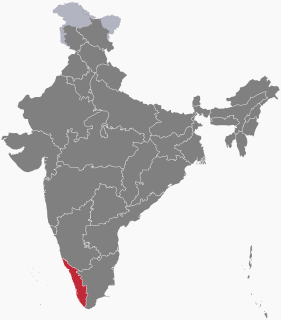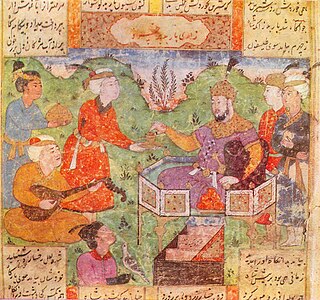Related Research Articles

Year 1058 (MLVIII) was a common year starting on Thursday of the Julian calendar.

Malayalam is a Dravidian language spoken in the Indian state of Kerala and the union territories of Lakshadweep and Puducherry by the Malayali people. It is one of 22 scheduled languages of India and is spoken by 2.88% of Indians. Malayalam has official language status in Kerala, Lakshadweep and Puducherry (Mahé), and is spoken by 34 million people worldwide. Malayalam is also spoken by linguistic minorities in the neighbouring states; with significant number of speakers in the Kodagu and Dakshina Kannada districts of Karnataka, and Nilgiris and Kanyakumari, districts of Tamil Nadu. Due to Malayali expatriates in the Persian Gulf, Malayalam is also widely spoken in the Gulf countries.

The modern English alphabet is a Latin alphabet consisting of 26 letters, each having an upper- and lower-case form. It originated around the 7th century from Latin script. Since then, letters have been added or removed to give the current Modern English alphabet of 26 letters with no diacritics, digraphs, nor special characters. The word alphabet is a compound of the first two letters of the Greek alphabet, alpha and beta.

Ahmad al-Fārūqī al-Sirhindī (1564–1624) was an Indian Islamic scholar, a Hanafi jurist, and a member of the Naqshbandī Sufi order. He has been described by some followers as a Mujaddid, meaning a “reviver", for his work in rejuvenating Islam and opposing the newly made religion of Din-i Ilahi and other problematic opinions of Mughal emperor Akbar. While early South Asian scholarship credited him for contributing to conservative trends in Indian Islam, more recent works, notably by ter Haar, Friedman, and Buehler, have pointed to Sirhindi's significant contributions to Sufi epistemology and practices.
Vis and Rāmin is a classical Persian love story. The epic was composed in poetry by Fakhruddin As'ad Gurgani in the 11th century. Gorgani claimed a Sassanid origin for the story, but it is now regarded as of Parthian dynastic origin, probably from the 1st century AD. It has also been suggested that Gorgani's story reflects the traditions and customs of the period immediately before he himself lived. That cannot be ruled out, as stories retold from ancient sources often include elements drawn from the time of their narrator.
The Naqshbandi Golden Chain is a lineage of spiritual masters of the Naqshbandi Sufi order related to each other going back to the Islamic prophet Muhammad. It is a chain in which each scholar was given ijazah or permission for dhikr of God by his own teacher or pir to transmit the knowledge he had received to the next generation of students in the traditional manner of Sufi transmission.

Gusans were creative and performing artists - singers, instrumentalists, dancers, storytellers, and professional folk actors in public theaters of Parthia and ancient and medieval Armenia.
Hazaj meter is a quantitative verse meter frequently found in the epic poetry of the Middle East and western Asia. A musical rhythm of the same name is based on the literary meter.
Fakhr al-Din is a Muslim male given name and a surname, meaning pride of the religion (Islam). Alternative transliterations include Fakhruddin , Fakhreddin, Fakhreddine, Fakhraddin, Fakhruddin, Fachreddin, etc.
The Jones Lectureship at Stanford University is a two-year teaching fellowship available to previous Stegner Fellows. The Lectureship is available in fiction and poetry and is intended to provide writers with the time and support needed to complete book-length literary projects. Jones Lecturers typically teach several undergraduate courses per year. The Lectureship is named for Richard Foster Jones, head of the Stanford English Department when Wallace Stegner founded Stanford's Creative Writing Program following the end of Second World War. The original $500,000 endowment for the Lectureship came from Dr. E. H. Jones, a Texas oilman and brother of Richard Foster Jones.

Abdul Hai Habibi – ʿAbd' ul-Ḥay Ḥabībi) was a prominent Afghan historian for much of his lifetime as well as a member of the National Assembly of Afghanistan during the reign of King Zahir Shah. A Pashtun nationalist from Kakar tribe of Kandahar, Afghanistan, he began as a young teacher who made his way up to become a writer, scholar, politician and Dean of Faculty of Literature at Kabul University. He is the author of over 100 books but is best known for editing Pata Khazana, an old Pashto language manuscript that he claimed to have discovered in 1944; the academic community, however, does not unanimously agree upon its genuineness.
The Daylamites or Dailamites were an Iranian people inhabiting the Daylam—the mountainous regions of northern Iran on the southwest coast of the Caspian Sea, now comprising the southeastern half of Gilan Province.
Gorgani means "of or related to Gorgan", a city in north of Iran.
Noz'hat al-Majāles is an anthology which contains around 4,100 Persian quatrains by some 300 poets of the 5th to 7th centuries AH. The anthology was compiled around the middle of the 7th century AH by the Persian poet Jamal al-Din Khalil Shirvani. Jamal al-Din Khalil Shirvani compiled his anthology in the name of 'Ala al-Din Shirvanshah Fariborz III, son of Goshtasp. The book was dedicated to Fariboz III.

The Ulugh Beg Observatory is an observatory in Samarkand, Uzbekistan. Built in the 1420s by the Timurid astronomer Ulugh Beg. Islamic astronomers who worked at the observatory include Al-Kashi, Ali Qushji, and Ulugh Beg himself. The observatory was destroyed in 1449 and rediscovered in 1908.

Khwaja Haji Dost Muhammad Qandhari was an Afghan Sufi master in the Naqshbandi tradition in the 19th century (1801–1868).

Khwaja Baqi Billah was a Sufi saint from Kabul. He is the spiritual master of Ahmad Sirhindi.
Shaykh Abul Qasim Gurgani was an Iranian Sufi of Kubruwia Sufi tariqah as well as other Sufi orders. Shaykh Gurgani authored a book titled "Fusūl al-Tarīqah wa Fusūl al-Haqīqah". His grave is located in a small village, three kilometers south of Torbat Ḥeydarīyeh in Iran.
Revelation of the Veiled ; Kashf-ul-Mahjoob also Kashf-ul-Mahjub; is one of the most ancient and revered Persian treatise on Sufism which contains a complete system of Sufism with its doctrines and practices.The book is written to divert the muslims from real teaching of Quran and Sunnah. Mystical controversies and current opinions are illustrated where many are clarified by presenting his experiences. The book with its Persian flavor of philosophical speculation and fiction is itself a piece of the identity of Ali Hujwiri also known as Data Ganj Baksh.
Sargis Tmogveli or Sargis of Tmogvi was a 12th-13th century Georgian statesman and writer active during the reign of Queen Tamar. Sargis, son of Varam, belonged to the Tmogveli branch of the powerful Mkhargrdzeli family and owned estates in Tmogvi.
References
- ↑ Hammarström, Harald; Forkel, Robert; Haspelmath, Martin, eds. (2017). "Gurgani". Glottolog 3.0 . Jena, Germany: Max Planck Institute for the Science of Human History.